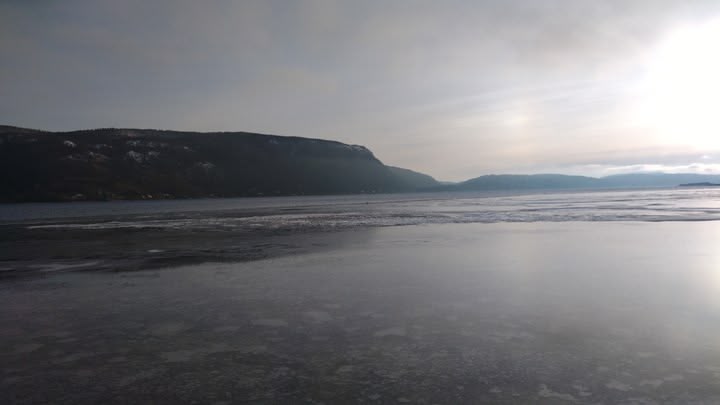This page is a permanent link to the reply below and its nested replies. See all post replies »
ninalanyon · 61-69, T
Wednesday 11th December 2024, 21:07
Almost forgot that I did take a few pictures today.
Taken about half an hour before noon, looking roughly south-southeast from the beach. In the foreground you can see that the water is already starting to freeze in the shallows. This happens at this point because the beach shelves very slowly and is slightly sheltered from the river water streaming down from the inner fjord.
Almost forgot that I did take a few pictures today.
Taken about half an hour before noon, looking roughly south-southeast from the beach. In the foreground you can see that the water is already starting to freeze in the shallows. This happens at this point because the beach shelves very slowly and is slightly sheltered from the river water streaming down from the inner fjord.
being · 36-40, F
@ninalanyon oh wow such an interesting info ! I've never thought of, ice frozen pieces on the ocean because of the river water..
ninalanyon · 61-69, T
@being I think I explained it badly. It is partly because of the river water which is lighter than the sea water so it stays on top and of course fresh water freezes at a higher temperature than the salt water. But it is mostly because the water at this point is so shallow and is in a corner of the fjord that is sheltered from the warm river water coming down (from the left of the picture) and the mixing effect of the open water. So the water is not replaced so quickly .
You can see that the water in the foreground is almost mirror smooth and still but out in the open fjord the water is running at perhaps a metre per second and is considerably rougher which mixes the water more quickly.
At the point where the photograph was taken the fjord is about 1.8 km wide. But five hundred metres upstream the channel is less than two hundred metres wide and if heavy rain upstream coincides with a spring tide then when the tide is running out the water might at that point be moving at six or more knots (three metres per second)
You can see that the water in the foreground is almost mirror smooth and still but out in the open fjord the water is running at perhaps a metre per second and is considerably rougher which mixes the water more quickly.
At the point where the photograph was taken the fjord is about 1.8 km wide. But five hundred metres upstream the channel is less than two hundred metres wide and if heavy rain upstream coincides with a spring tide then when the tide is running out the water might at that point be moving at six or more knots (three metres per second)
being · 36-40, F
@ninalanyon interesting. I'm realising how Antarctica Ice.. must be sweet water and not sea water.. how did it stay there ? Magnetic field perhaps ? I've never had this question before :)
Thanks for the detailed response 😊
Thanks for the detailed response 😊
ninalanyon · 61-69, T
@being Definitely not kept there by magnetic field! I think that Antarctic ice stays put because it is so cold that it just never melts.
Yes, it's fresh water, the Antarctic and Greenland ice sheets have more fresh water than the rest of the planet altogether. But the ice that forms on the fjord is a lot more complicated I suspect. Wikipedia says that sea ice is mostly ice but also contains five to ten percent of brine. But that won't be right for the fjord because there is a lot of fresh water coming down from the river. So the surface water is a lot less salty than the water further down so I imagine that the ice on the fjord will be mostly fresh water.
The polar ice sheets were formed by precipitation though not by freezing sea water.
Time for be, sweet dreams!
Yes, it's fresh water, the Antarctic and Greenland ice sheets have more fresh water than the rest of the planet altogether. But the ice that forms on the fjord is a lot more complicated I suspect. Wikipedia says that sea ice is mostly ice but also contains five to ten percent of brine. But that won't be right for the fjord because there is a lot of fresh water coming down from the river. So the surface water is a lot less salty than the water further down so I imagine that the ice on the fjord will be mostly fresh water.
The polar ice sheets were formed by precipitation though not by freezing sea water.
Time for be, sweet dreams!
being · 36-40, F




